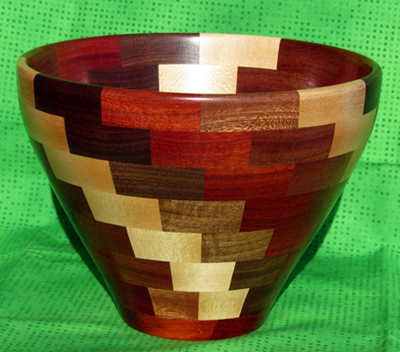
Here's My Woodturning!
by Paul Bucca
Boise, ID
Note: click any picture to see a larger version.
My wood turning career began 12 years ago shortly after retirement. I made my first mistakes while turning green wood (you WILL make mistakes, but don't let this deter you). Initially, I found lathe turning to be very intimidating, on occasion, hurling wood across my basement. After a while, I realized that the final results of a green wood turning could be very different from my initial design. The drying process often resulted in a twisted and checked finished product.
In the last four years, I gravitated to the precise art of segmented bowl turning. If a segmented turner does not have a good dose of patience and an eye for extreme accuracy, this art form will not appeal to you. My design tools include several vernier calipers and protractors which are helpful to produce a perfect circle (within several thousand of an inch) of the segments in a ring of a bowl. If the angular measurements of each segment in a ring are not precise, a gap will materialize when it is assembled and the error will be elevated to the new focal point of the turning. The construction of segmented bowls requires a myriad of jigs. It is these devices that help impart consistency and accuracy to bowl construction. Since precise segment angle and size repetition is essential, a general rule is that what you do to one segment, you do to all segments.
Four years ago, my first segmented turnings resulted from following step by step directions available in several books. Soon I was able to independently design my own bowl shapes by viewing finished works on-line or in other books. I next began to design customized rings without having to rely on a step-by-step pre existing pattern. My vessels began to take on a somewhat unique quality when I discovered (with the help of my wife who quilts) that I could incorporate in my rings very attractive complementary wood colors which I had observed in other turnings. In my quest for producing a unique piece, I often use medallions in the base of my bowls. My recent acquisition of a scroll saw opens many new possibilities in the design of my bowl base. For instance, I am considering the incorporation of a solid backed fretwork base in my segmented pieces.
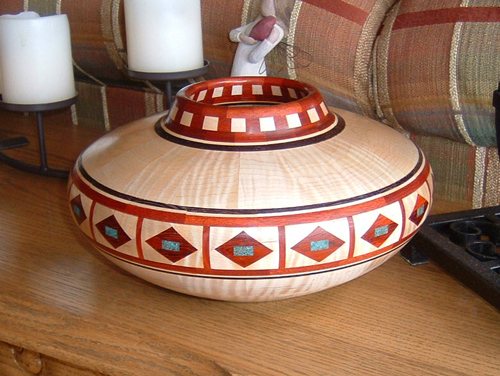
This is a "knockoff" of a Ray Allen bowl featured in his book "
Woodturning with Ray Allen". However I can call it an original because it is an 18 segment bowl (his is a 16), the bottom is constructed of a maple plug embedded in Ebony rather than a solid wood piece, I assembled and finished the hemispheres independently rather than hollowing the bowl from the top entrance, and I used several wood species that differed from the Allen plan. In addition, I constructed it in a totally different way than the book directed.
The piece was just completed and contains 487 pieces and took me 107 hours to construct. It is very nearly 12" in diameter and consists of curly and soft maple, bloodwood, wenge, and ebony. The turquoise in the feature ring was fashioned from a two part resin. I finished the bowl with
Mylands High Build polish. When finishing it, I had a considerable problem in preventing the oily bloodwood from bleeding into the very light curly maple and solved it by finishing both wood species independently with cotton swabs. This effectively sealed the wood which enabled me to apply the final layers by mounting it on a revolving lathe. I have been constructing segmented bowls for 3 years and this is my fifth bowl.
The development of a unique feature ring (the ring in a segmented piece that is often the most complex) taxes my creative abilities the most. I am at the entry level of designing unique feature rings which will result in a unique and attractive turning. I am challenged by how to visualize cutting and rearranging wood to achieve a desired pattern.
Recruiting a mentor who lives in your locale to teach you this art form will greatly accelerate your learning curve - don't hesitate to ask. Generally members of the segmented bowl community are eager to teach newcomers their art. Joining a local wood turner's group is also a good first step in accelerating your learning experience. The evolution from a "follow the directions" turner to producing a unique art form is an extremely rewarding process. If I can be of assistance, my e-mail address is
pjbucca@msn.com.
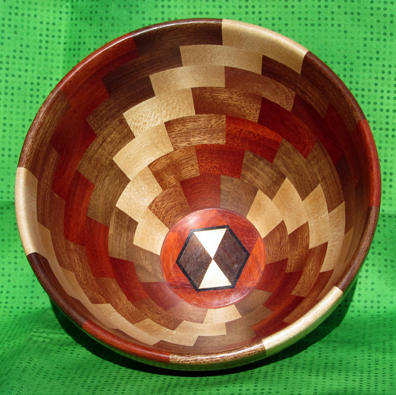

Multicolored Bowl
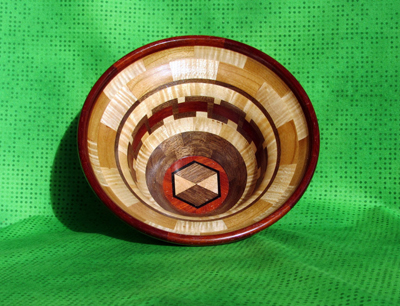
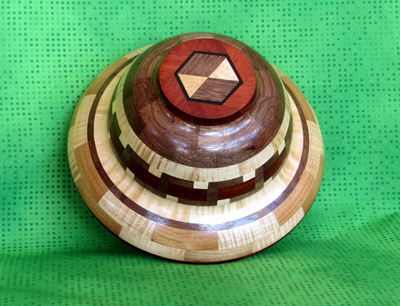
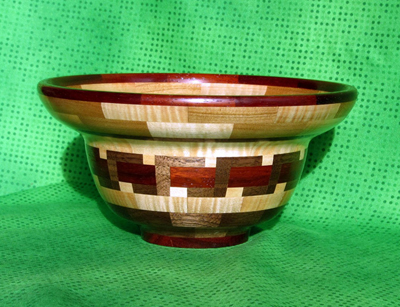
Interwoven Bowl
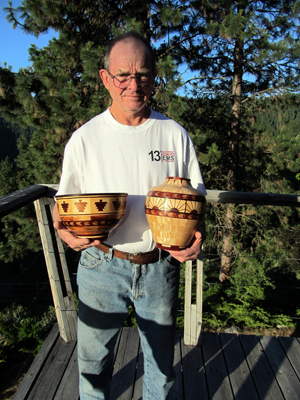
Two of my recent turnings.
You can email Paul at
pjbucca@msn.com.
Submit your own woodturnings to this column! Simply
SEND US PHOTOS
of your woodturning
projects along with captions and a brief history and description of your woodturning. (Email photos
at 800x600 resolution.) Receive a $50 store credit if we show your turning in a future issue!
